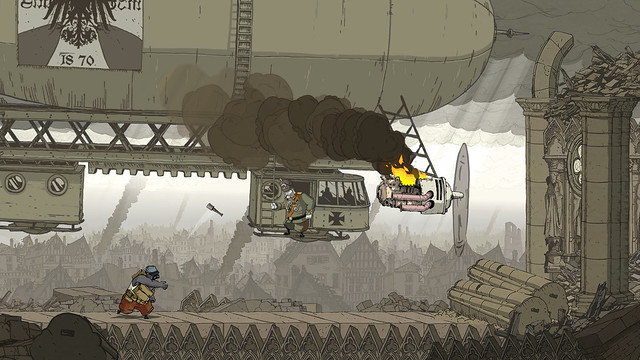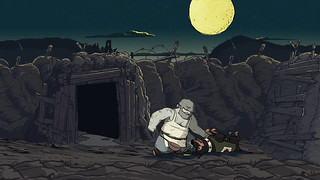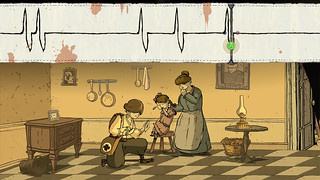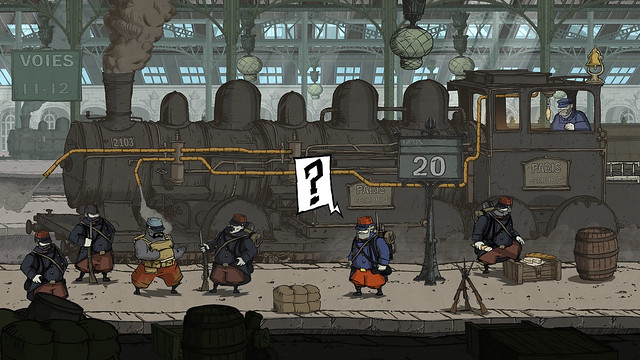
Hello, my name is Simon Chocquet-Bottani, Game and Level Designer on Valiant Hearts: The Great War for PS4 and PS3, out today. When we started making Valiant Hearts, we immediately knew what sort of feelings we wanted the game to evoke. That has been our guiding principle throughout the game development process. We tried to make a game that will captivate you and take you on an emotional journey. We also wanted to make sure we stayed true to history, so we built the basis of our story around real events and real places.
As we were moving through and creating prototypes, we recognized many aspects of the war we wanted to talk about. This brought us to the idea of creating not one, but four main characters, each of them with their own experiences and interpretations of the war. By switching between the four characters, we’re able to tell a story with several cliffhangers, as well as lighten the moments between happiness and sadness as needed. The art style fit this concept perfectly because it allowed us to take people on an emotional adventure where they could be laughing or crying at any period of time.
We didn’t want to present a black-or-white stance or point fingers showing that these are the bad guys and these are the good guys. We didn’t want to portray the war like you’d usually find it, but rather tell the individual stories of a farmer, a student, a son, a daughter, and all of these families torn apart during The Great War. From the beginning, we knew that Valiant Hearts was not going to be the typical action-shooter war game; we really wanted to move away from this idea of a war game to making a game about what happens to people during war.
Through research quite early on, we found unique, unknown stories that shed a human essence to the otherwise atrocities of the time — stories of dogs in the trenches and how the men cherished them because of their innocence and the way that they were able to bring joy to the soldiers by playing with them and even help out in certain situations. This fits exactly with the vision we wanted to convey, that people are not inherently bad. And you can see this in the way the dog looks at the characters and how he interacts with them.
In order to make the gameplay mesh with the story and moods of the different situations, we chose a slow-paced puzzle approach and created the core gameplay so that it can be adapted to any situation. Our characters can pick up objects, throw them, activate different things in the background, and punch. By modifying the use of this basic mechanic based on the context, we were able to create a wide variety of situations while keeping the game fairly easy to play.
We really wanted to foster an overall feeling of immersion in the story. For example, to use a lever it will ask you to hold a button for your character to hold the lever, and then mimic the action you want your character to perform using the stick on the controller. The use of intuitively reproducing the same action the character is doing on screen with your joystick allows the creation of a lot of diversity while keeping the game mechanics intuitive. Of course, we wanted to create a specific bond between the player and the dog, so it was essential for us that the dog be part of the actual gameplay. He needed to have unique abilities that would complement the player’s. A button allows you to enter “dog mode.” In this mode, you can give commands to the dog, such as asking him to fetch, come here, go over there, etc.
Each character also has specific abilities that give this feeling that each one is representative of a different aspect of the war. Emile is older, wiser, and slower than the other characters. He does not want to fight, and so most of his maps will be puzzle-oriented, though he will be confronted with other diverse situations in the game, such as digging through the ground to avoid direct combat. Freddie is more aggressive and action-oriented because of his back story and will very often be close to the action. Anna has a particular healing gameplay which is based on a rhythmic game. This gameplay is meant to make you feel the urgency of saving someone’s life by having to react quickly while at the same time remaining precise and accurate. Karl is also an unwilling fighter and he really wants to solve things peacefully, so his ability is being able to disguise himself in order to get out of difficult situations without having to enter into any conflict. The levels in which you play Karl are mostly stealth-based.
In order to focus on this more “humanized” side of the war, we were very careful not to have the characters kill anyone. The war kills people, but none of the characters do. We really thought that enabling players to kill someone would lead to a break in the bond between player and the character and would confuse the game’s overall message. Even while performing an indirect action, such as destroying a bridge, we made sure to show the player that the soldiers on the bridge escape BEFORE the explosion.
In the end we are really happy with Valiant Hearts. The balance between gameplay, narration, and history was an interesting challenge for all of us, but thanks to our experience from a wide range of different game types, such as Rayman Origins, Rayman Legends, Beyond Good and Evil, King Kong, From Dust, Raving Rabbids, and others, we were able to create something unique and different.
This balance allowed us not only to create a game with compelling gameplay, but also to give people a touching story, and even a World War One history lesson! We’re really looking forward to see how people will experience the game for themselves — it was made with a lot of passion and love!
We hope you enjoy the game!















Comments are closed.
44 Comments
Loading More Comments